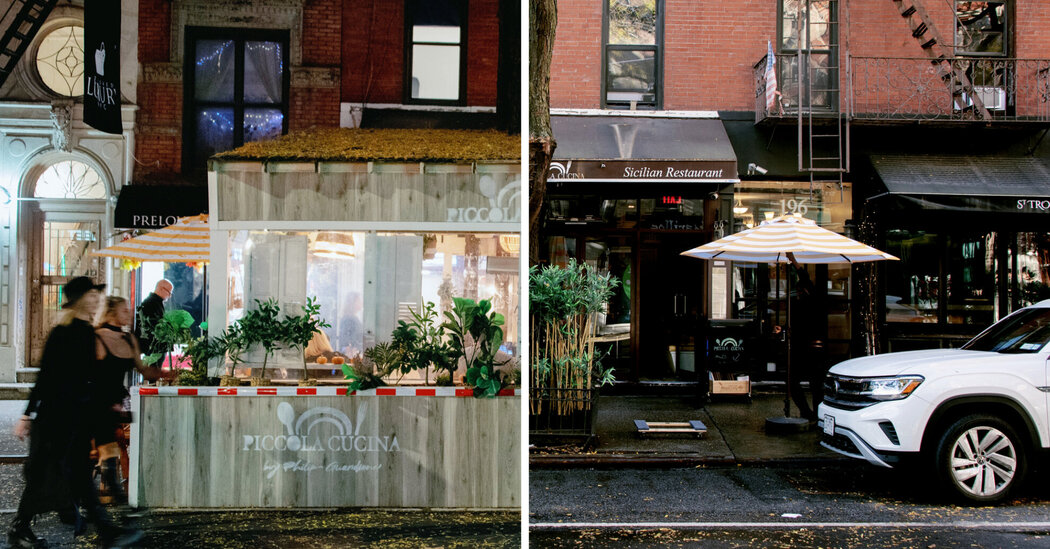A stack of yellow and red bands drip from the top of “Painted Rain #3” (2022-23), a painting by the artist Pat Steir. Coalescing against a bright turquoise backdrop with layers of poured-on paint, the combination imbues the artwork with the sense that you’re peering into a sun shower. Hanging vertically at nine feet, the monumental canvas is part of a new series by Steir — on view at Hauser & Wirth’s West Hollywood gallery — dedicated to the color blue, an exploration that was catalyzed in part by a visit to a “very thorough” ophthalmologist eight years ago, says Steir, 85. “He gave me a color [vision] test and, when he was done, he said, ‘You’re colorblind. You can’t see the color blue,’” she recalls. The diagnosis was not entirely surprising — Steir knew she struggled to discern certain shades from others — but as an artist whose experiments with gesture and color have helped to redefine the canon, the confirmation set her on a new path. She began to scrupulously mix her paints to achieve subtly different hues, then unleashed them on her canvases. “Now I can see many kinds of blue,” she says.
The canvas “Painted Rain #5” (2022-23), another work from the series, resembles the scene at Steir’s studio when I meet her there one cold evening in February. The painting’s velvety midnight blue backdrop is lit with strokes of brilliant orange and deep jewel tones, which seem to emulate the water of the Hudson River outside her window, rippled and purple as a date, when it reflects the artificial light emanating from a nearby apartment complex. One of many units in a colossal building in New York’s Chelsea neighborhood, her work space is vast and airy. At its center rests a wooden table atop which she has organized her paints into neatly labeled plastic buckets. Sitting below the desk are cartons of Turpenoid, a thin and odorless turpentine substitute that Steir uses to dilute her pigments. She tests her concoctions directly on the walls of the studio, and one such surface resembles a grand quilt, blanketed with bleeding swatches of mustard, maroon and, of course, blue.
Steir moved her work space in 2004, and she’s quick to point out how things have changed over the years. “Before they built these buildings, I could see all the way to the George Washington Bridge,” she says, lamenting the loss of natural light. The artist turns to nature as a perennial inspiration for her paintings, which tend to evoke seaside landscapes and rushing rivers with their showers of flicked and dripped pigment. And though she has exhibited widely since the ’60s — her first solo show was at the Terry Dintenfass Gallery in New York in 1964 — the work that has come to define her practice, her “Waterfall” paintings, wasn’t developed until the late ’80s, in a studio in SoHo just a few miles south from where she is now. To create the first work in the series, “Sixteen Waterfalls of Dreams, Memories, and Sentiment” (1990), Steir stood atop a ladder and poured paint onto an unstretched canvas, allowing gravity, time and the weight of the paint to decide where the color eventually landed. The finished piece, versions of which she went on to make by flinging and throwing paint, is now in the collection of the Metropolitan Museum of Art.
Steir no longer works while balancing on a ladder. An accident in her Greenwich Village home in 2019 left her with mobility issues for which she continues to see a physical therapist; she answers T’s Artist’s Questionnaire with a cane within reach. Yet painting remains an integral physical and even spiritual exercise for the artist. Today she reaches the peak of her canvases by riding a scissor lift, which sits behind her worktable, its metal bars speckled with globs of paint in many different colors.
What is your day like? How much do you sleep, and what’s your work schedule?
I sleep anywhere from three to eight hours. I wake up at 7 and have a coffee. At 9, I get out of bed and shower, dress and hang around a little bit. And then I come to the studio between 12 and 1 and I start working. I’m working on mail in the studio now and starting drawings because I did all the painting I should do.
How many hours of creative work do you think you do in a day?
It really depends. My rule is to make at least one brushstroke per day so the day isn’t wasted. You can see I have a lot of physical problems and it’s surprising that I could paint these big things. But I can, because it’s my exercise. It’s what keeps me going.
What’s the first piece of art you ever made?
A painting of a tree outside my window when I was 5.
Where did you live then?
Someplace in New Jersey. My name is Patricia, but my little brother couldn’t say “P,” so my name became “Tree.” Puh-tree-shuh. I identified with the tree outside the window.
Did you often paint as a child, or were you doing other kinds of art?
I probably did a lot more with pencils, like the pencil you have in your hand. My father bought me a little oil painting kit, and I was very neat. I didn’t get paint around the house. I just painted on my canvas like a good girl.
What’s the worst studio you ever had?
The studio I had in 1990 on Broome Street. It was on the ground floor. It had a skylight in the back and a garage. The drain in the sink didn’t work, so whenever I washed brushes, the sink would fill up with water for a few days and then go down. That’s the worst physical space I had, but I painted the best paintings I ever painted in that space.
Which paintings were those?
The waterfalls.
What’s the first work you ever sold? For how much?
It was a painting of a little dog. [It was] maybe 1969, 1972, around there. And I think I sold it for $200. I was happy to have that.
When you start a new piece, where do you begin?
The first step is to prime the canvas, to put on the ground color. [But] the first real step is the first brushstroke, and where that’s placed on the canvas.
What process goes into deciding where you’ll place that brushstroke?
There is a thought process, but I can’t say what it is. It’s internal and abrupt. Usually, I imagine a painting in my mind and then I paint it on the canvas. Of course, it’s different when I paint it on the canvas. The rule is to not mess with it. When I put a mark down, that’s the mark. I don’t change it. Then I let the paint fall down from the mark because I’m curious about what will happen. I go away after I make each one. I have to wait for the mark to dry before I make the next one.
How do you know when you’re done?
The painting tells me. The painting says, “Go away! I’m finished! Don’t mess with me!”
What music do you play when you’re making art?
I listen to Indian music, something that’s reminiscent of traveling for me. I don’t listen to anything that would be jarring.
Is there a meal you eat on repeat when you’re working?
We only have two restaurants we order from, and we’ve been here for 20 years. Vegetable soup, chicken soup — that’s what we can get from the new food court downstairs.
Are you bingeing on any shows right now?
I watch the news every night. I always think I’ll watch a film when the news is over, but the news takes so long that there’s no time for the film. I watch Rachel Maddow, [Alex] Wagner and some man who’s lost his hair while I’ve watched him.
How many assistants do you have?
One who comes three days a week. One who handles the photographs and paperwork. And [one] who takes care of my drawings inventory.
What other jobs did you do before you could support yourself as an artist?
Right after I graduated, I worked for the welfare department on 125th Street. It was 1962.
How long did you work there?
A couple of years. It was a hard job if you were a kid because you really witnessed tragedy. Especially at that time, people who were on welfare were being punished. You weren’t allowed to tell teenage women about birth control. It was against the rules. Some of them were so young that they didn’t know how the baby got there. They were in disbelief.
After that job, I couldn’t do it anymore, so I got a job as an art director at a publisher, Harper & Row. Now it’s called HarperCollins. It was easy for me because I studied design [at the Pratt Institute in New York, from which Steir graduated in 1962] and, as an art director, I didn’t have to do the designs. I could buy them from artists. I could assign an artist a book and say, “Do the gutter for that.” I could call a printer and say, “Do this and this,” and, “That’s too dark.”
When did you first feel comfortable saying you’re a professional artist?
Yesterday. [Laughs.] I’m serious. Who would dare to say, “I’m a poet” or “I’m an artist”? It sounds so overblown. It’s such a brief description of what this is to me. The thing is, I only wanted to be an artist. I only wanted to do this work in my life. Nothing else. I saw anything that stood in my way as an inconvenience. When I started out being one of few women in the men’s art world, I saw those 9,000 men and two other women as inconveniences. I said, “Oh, that’s inconvenient. They’re in my way.”
How often do you talk to other artists?
Very often. Kiki Smith. Julie Mehretu, [whose studio is just] across the hall. Anne Waldman, the poet. I speak with Anne almost every day.
What do you do when you’re procrastinating?
When it’s sunny out, I like to go outside. I love Washington Square Park. I live near it.
What’s the last thing that made you cry?
A very old and dear friend of mine died two weeks ago. It was expected. She was fighting cancer for about five years. Her death made me cry, when I saw her son cry. That’s what happens when you get old — people die. But I’m surprised to be so old. When I did the Hirshhorn show [“Pat Steir: Color Wheel” from 2019 to 2021], I thought I was 20 years younger.
What do you usually wear when you work?
Old clothes. I put aside clothes when they get too old to feel dressed-up in. I have a wardrobe of old clothes.
What do your windows look out on?
The Hudson River, the light from off the river. I look at some part of New Jersey that just got built up, too. Both sides of the river are getting higher and higher. I had a much better view before all the buildings went up.
What do you bulk buy with most frequency?
Turpenoid and black charcoal.
What’s your worst habit?
Telling other people what to think.
Do you exercise?
Yes, I work out with a trainer. I have to move because it’s hard for me to move, and so I stand up and walk with him. Doing the painting is a lot of incredible exercise.
What are you reading?
Siddhartha Mukherjee’s “The Song of the Cell.” He can make even a small illness come alive. He’s a good friend, but his book is not easy to read.
What’s your favorite artwork by someone else?
Velázquez’s paintings of court jesters, particularly [“The Buffoon Calabacillas,” (1635-39)]. When I saw that painting in Spain, I thought, “That’s me.” He’s at the court so he can be entertainment. Even if I think of it, I’m going to cry.







